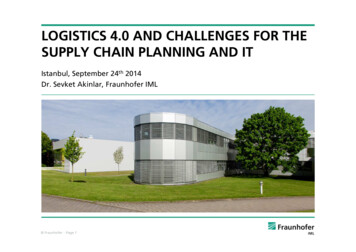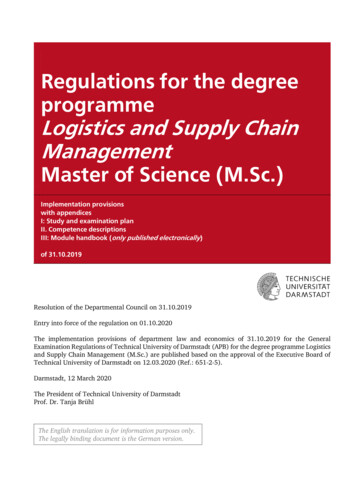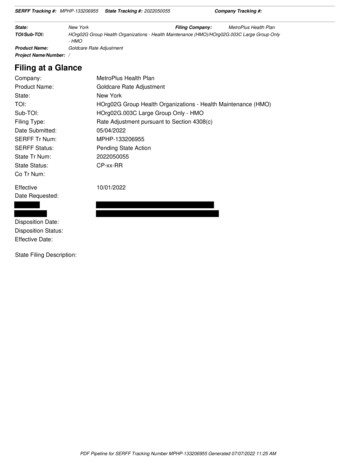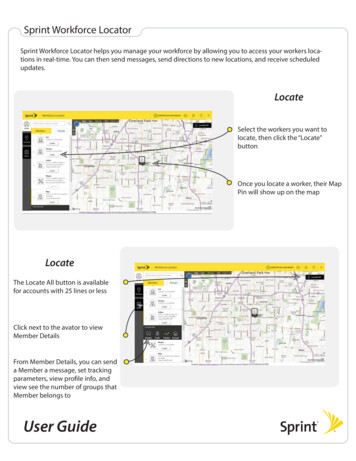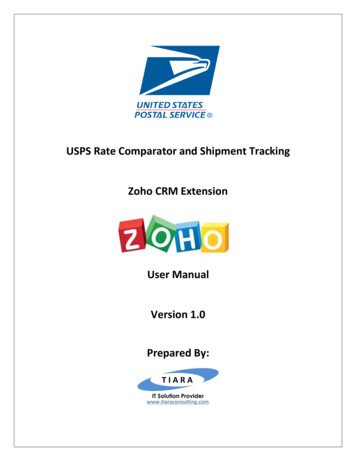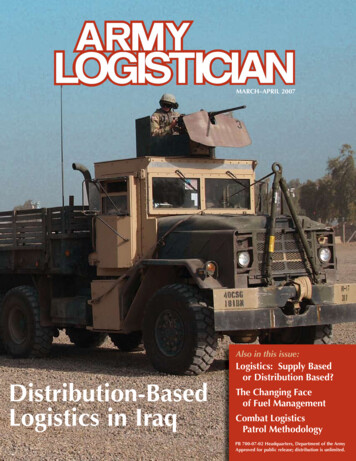Transcription
Paper–An Intelligent Logistics Tracking System Based on Wireless Sensor NetworkAn Intelligent Logistics Tracking SystemBased on Wireless Sensor un XingNorthwest University of Political Science and Law, Xi’an, Shaanxi, Chinalfwv82271723xu@163.comAbstract—In view of the shortcomings in information collection and tracking management in existing logistics, the key technologies of wireless sensornetwork and the basic concepts and methods of Information Technology Infrastructure Library(ITIL) is studied. The basic structure and main functions of thelogistics tracking system based on wireless sensor network is put forward. It caneffectively solve the detection, location, recognition and automatic processingof fault events and other issues of goods in the process of logistics trackingmanagement. In addition, combined with the GIS software, the logistics tracking and monitoring system based on the wireless sensor network is realized byusing Java language coding. The results show that this system can realize thetracking, visualization and automatic management of the information in theprocess of goods transportation. Therefore, the proposed method significantlyimproves the accuracy, rapidity and intuition of the logistics information management.Keywords—wireless sensor networks, logistics tracking, monitoring system,ITIL1IntroductionAt present, with the rapidly development of economic globalization and information technology, the service economy has developed rapidly in the world, and thelogistics industry as a new service sector has been rising rapidly in the world [1].More and more abundant materials bring convenience to people's lives, but also bringsome impact. How to store and transport the large number of goods with variouskinds for effective information management has become an important issue. In theprocess of information management, it needs to track and trace the materials, and canautomatically deal with the fault events. The traditional management methods are nolonger applicable. The emergence of wireless sensor network provides the methodsand ideas for solving these problems. wireless sensor network can connect any itemsto the Internet through RFID, WSN and other information sensing equipment. It canachieve information exchange through the network, and is provided with the fastacquisition speed and high degree of automation. The logistics tracking managementsystem based on wireless sensor network can realize the whole process visual controliJOE ‒ Vol. 14, No. 1, 201817
Paper–An Intelligent Logistics Tracking System Based on Wireless Sensor Networkof purchasing, transportation, storage, distribution and use in the logistics supplychain, and can automatically deal with the fault events and promote the logistics management information [2].Because of the time-sensitive nature of the perishable food, it is required that thecold chain be able to perform the real-time low-temperature environmental monitoring function and keep the cold chain's low-temperature transportation environment,therefore keeping the low temperature environment is the core requirement of the coldchain system. If the temperature control is not accurate enough, it will lead to a seriesof low-quality products [3]. Each link of cold chain, from the picking of the productto being sold out, need to participate in control. Every link in the chain can go wrongand break the cold chain, either on the platform of a warehouse, in transit, in storage,or in a retail supermarket, which can affect the final consumer’s demand. At present,China's cold chain monitoring system is relatively sound, and sound monitoringmeasures have been taken in the production, storage and sales. But the cold chainmonitoring in the transport is relatively weak. Cold chain system based on wirelesssensor network makes sure that the food is transported in the specified lowtemperature environment to keep the original freshness, color and nutrition of thefood and ensure the food quality and safety [4].2State of the artWireless sensor network is a series of independent systems built on the part of infrastructure of existing Internet. It has a unique intelligent infrastructure. Radio Frequency Identification (RFID) is one of the key technologies of wireless sensor network. The wireless sensor network can collect information fast and accurately withRFID technology, and make the information interconnect with the traditional Internet[5]. Communication modes of wireless sensor network includes things and thingscommunication, things and people communication, people and people communicationand other different types, which makes the virtual network world extend to real life.The practical application of the wireless sensor network provides a new opportunityfor the development of the logistics industry, gives the goods in the process oftransport intelligence, and turns the logistics information management into intelligent.Instrumented, networking, perception, automation and intelligence are the basic characteristics of things [6].The intelligent, location, tracking, monitoring and management of the wireless sensor network is embodied in the field of logistics as a centralized data processing andservice center based on the network. It uses radio frequency identification devises(RFID) to collect material information, and transmits information to the data servicecenter through the network. It also integrates the material information on the mapdisplayed by GIS system to achieve the visibility control of material [7-8].In foreign countries, the intelligent logistics starts some earlier. The developmentof intelligent logistics of some countries in Europe and the United States is in a leading position. In the United States, the federal logistics company developed a set oflogistics system based on wireless sensor network for real-time monitoring of logis-18http://www.i-joe.org
Paper–An Intelligent Logistics Tracking System Based on Wireless Sensor Networktics. The system calculates the data uploaded through the sensor in the server-side, ifthe logistics has problems, it can alarm in time. And the user can monitor the dynamicof the goods in time, which is easy to transport some dangerous goods, fragile goodsand high value goods. Caterpillar has developed a system which is specifically designed for intelligent logistics. The system can simulate, plan, evaluate and forecastthe process of warehousing and freight transportation. In Japan, the intelligent logistics develops rapidly, and the intelligent logistics is applied in the logistics transportation of cold chain, fresh chain and chemical industry [9].In the country, the national policy attaches importance to wireless sensor network,and more and more technology companies want to develop on the intelligent logistics.The development of intelligent logistics of some traffic hub cities in China is muchhigher than other cities. Major electronic business develops rapidly in the field of ecommerce, but also aware the importance of the logistics industry in the supply chain,have increased logistics construction, and Jingdong, Suning and other electricity providers continue to invest in logistics warehousing. With the rapidly development ofupstream and downstream industries of supply chain, the logistics industry has alsobeen paid more and more attention [10]. At the same time, the arrival of the era oflarge data brings opportunities and challenges to the development of intelligent logistics. The storage, processing, query of logistics information uploaded all the timemakes the traditional data storage become powerless. Therefore, the new logisticsinformation system of wireless sensor network should improve the storage way ofdata.3Methodology3.1The overall structure of systemThe system is mainly divided into server layer and application layer. The serverlayer is the bottom of the application layer. Server layer will deal with the distributionof goods, invoicing and inventory information collected through a variety of sensors[11]. Application layer mainly turns the information processed by server layer intoevents, and stores the information in the database in accordance with the event formatrequired by logistics enterprises. And then the different information is showed to eachuser in the system interface according to the different user rights to query and maintain conveniently. The overall structure of logistics tracking system based on wirelesssensor network is shown in Figure 1.iJOE ‒ Vol. 14, No. 1, 201819
Paper–An Intelligent Logistics Tracking System Based on Wireless Sensor NetworkUser interfaceMbean interfaceDatabaseApplication layerServer layerRIFD readerRIFD readerRIFD readerFig. 1. Overall structure of logistics tracking system based on wireless sensor network3.2System compositionThis paper evaluates the advantages and disadvantages of wireless sensor networkcoverage optimization algorithm from the following aspects:Coverage rate: the coverage capability of network is an important index to measurethe performance of sleep mechanism. Network coverage is usually used to reflect thecoverage capacity of the network. In general, it is defined as the ratio of the effectivecoverage area Aa of the network to the area A of the target area, that is:Server layer. Server layer is divided into three layers: sensor abstraction layer, application engine layer and communication layer. The sensor abstraction layer providesa common API that integrates with the LLRP sensor adapter, the Alien sensor adapter,the Borcorde sensor adapter, and the DB sensor adapter to collect various data information from the sensor and generate raw events. The application engine layer filtersthe collected original events according to event handling rules to get the industrialevents needed by logistics ebterprises. Through the TCP and SOAP protocol, JMSand RMI technology, communication layer will use the event of the industry in theengine layer to integrate with other systems (such as: database, operation and maintenance systems, etc.)20http://www.i-joe.org
Paper–An Intelligent Logistics Tracking System Based on Wireless Sensor NetworkSensor abstraction layer: server layer connects to Borcorde reader, RFID reader,terminal mobile devices and wireless sensors and other sensors, from which to collectlogistics information for processing. The sensor abstraction layer allows the user tocollect all the information needed for the application in a transparent manner. Application Engine Layers: The application engine layer processes a large number of redundant events generated by the sensor abstraction layer and generates meaningfulevents needed by the logistics industry. The server uses a sophisticated event processing engine Esper that filters and identifies valuable events from a large number ofevent streams according to rules. Esper allows user to write query statements that aresimilar to database syntax. The overall architecture of the server layer is shown inFigure 2.BMIJMSSOAPTCPCommunication layerApplication engine layerSensor abstraction rFig. 2. Overall structure of server layerCommunication layer: the communication layer will submit the processed data tothe application system for integration to realize the information exchange. The designof various application interfaces in this layer achieves effective integration with theexisting application system.Application layer. Application layer mainly turns the event information processedby the server layer into the event information needed by the logistics industry, andiJOE ‒ Vol. 14, No. 1, 201821
Paper–An Intelligent Logistics Tracking System Based on Wireless Sensor Networkthen the event information is stored in the database for the display, viewing and dealing with in user interface. In the distribution process, there are two main events: normal events and abnormal events. The normal events include that the designated itemsreach to the designated location and leave the designated location. Abnormal eventsindicate that the items are not transported according to the requirements, which includes that items have missed a place, the goods are shipped back, the items don’tfollow the prescribed route to transport, and there is no corresponding item name andthe corresponding location name. The specific process is shown in Figure 3.Do not havecorresponding nameof itemsNormal arrive correspondingname of placeDo not havecorresponding nameof placeDelay in a placefor a long timeDo not havecorresponding name ofitemsNormal leaveHave correspondingname of itemsAbnormal eventsLeave eventsEventsTurn back a placeNormal eventsArrival eventsArrive afterskipping over aplaceHave correspondingname of items correspondingname of placeDo not havecorresponding name ofplaceFig. 3. Application layer events analysis3.3System flow designIn the logistics business process, the system refers to the best practice and the related standard of the ITIL, and designs the operable, distributed and automatic processing flow according to the event processing in the process of tracking the goods[12]. The design adopts the multi-flow method. The normal events stored in the database by the application layer are handled according to the event work order flow. Theabnormal events are processed according to the problem work order flow, and the22http://www.i-joe.org
Paper–An Intelligent Logistics Tracking System Based on Wireless Sensor Networkemergency situation such as line adjustment during the transportation of the goods isprocessed according to the change work order flow. Event work order can be generated automatically or manually by the failure alarm event during work order processing.Event work order can lead to change work orders and problem work order. Users andcustomers can query the detail information of the transport process of goods throughthe system's service desk. Maintenance personnel of logistics operation can deal withthe events produced in the transport of goods in accordance with the flow, and manage the assets of logistics enterprises.RFID module uses high-frequency RFID devices to collect data, and the goods intransit can be real-time queried. The user can get the information of the arrived itemsin time through text messages and Email, and can query the historical information.Geographic information system (GIS) is a comprehensive technical system that collects, stores, computes, retrieves, analyzes, displays and describes the geographicalinformation in the whole or part of the Earth's surface space, supported by the computer network system. The geographic information system has the function of displaying the geographical location information of the articles accurately. The system usesthis function and the official Chinese map API interface provided by Google to develop to realize the visualization of the geographical information during the transportation of goods, and can improve the accuracy of the display and maintain the articlesline. The event generated by the system is processed through the flow process interface in accordance with pre-designed ITIL process, including the event work orderprocess, the problem work order process and change work order process. The systemautomatically displays the work order to be processed on the corresponding labelcard. The system will automatically flow to the corresponding label card of the workorder handler of the next task node for the work order that the current node task isprocessed. In the process of the whole work order, the process of the work order is inthe closed-loop state, which greatly improves the efficiency of the work order processing.4Result analysis and discussionWith the continuous development of logistics management theory and the deepening of logistics practice, it is necessary to establish the corresponding logistics performance evaluation method. The corresponding performance evaluation index isdetermined, to objectively and scientifically reflect the operation of logistics system.Logistics performance evaluation index has its own characteristics, and its content ismore extensive than the current enterprise evaluation index. It not only replaces theaccounting data, but also puts forward some methods to determine whether the logistics system has the ability to meet the customer or market demand in time. In theactual operation, in order to establish an effective evaluation index system of logisticsperformance, the following principles should be followed when measuring logisticsperformance: First, the key performance indicators should be analyzed emphatically.Second, the performance index system should reflect the logistics business process.Third, the index should reflect the operation of the whole logistics system, rather thaniJOE ‒ Vol. 14, No. 1, 201823
Paper–An Intelligent Logistics Tracking System Based on Wireless Sensor Networkreflecting the operation of the single node enterprise. Fourth, the method of real-timeanalysis and evaluation should be used as far as possible. Logistics real-time operational information is more valuable than post-mortem analysis. Fifth, performanceevaluation indicators can reflect the relationship between suppliers, manufacturersand customers. Sixth, performance evaluation indicators should be able to fully reflectthe competitive advantage and competitive ability of logistics.According to the principle of LSC algorithm, LSC algorithm is a distributed algorithm. It can cluster nodes in the asynchronous state of sensor nodes, and can realizethe merging of different subnets. In addition, it has very strong extensibility. Nodeclustering algorithms that employ large-scale WSNs data collection also need to meetstability requirements. In order to evaluate the clustering stability of sensor nodes,simulation was carried out. The simulation parameters are shown in Table 1.Figure 4 shows the network size of 2000 sensor nodes. When the communicationdistance in the cluster is r 70m and the communication distance between the clustersis R 150m, the number of cluster head nodes and cluster member nodes in 15 clusters is observed. It can be seen that the number of cluster head nodes and clustermember nodes always tends to be stable. The number of cluster head nodes and cluster member nodes in a cluster process is shown in Figure 4.Table 1. Simulation parametersParameter nameParameter valuesTarget area1000!1000m2Number of nodes100 4000Node's communication radiusThe communication distance between the clusters is 150m, andthe communication distance within the cluster is 70m.Cluster head nodeCluster member node2000The number of nodes180016001400120010008006004002000012345678910 11 12 13 14 15 16The number of clustersFig. 4. The number of cluster head nodes and cluster member nodes in a cluster process24http://www.i-joe.org
Paper–An Intelligent Logistics Tracking System Based on Wireless Sensor NetworkThe influence of the number of sensor nodes on clustering is shown in Figure 5.r 70r 90r 110The number of cluster head e number of sensor nodesFig. 5. The influence of the number of sensor nodes on clusteringIn the simulation calculation, the number of sensor nodes changes from 100 to1500, and the interval increases by 100. When the number of nodes in the networkincreased to a certain scale, the number of cluster head nodes maintained at a stablelevel. The node density, which maintains the level of clustering stability, becomes thecritical node density for stable clustering. It is related to the average number of nodescovered by the sensor node communication radius range.In order to collect the three-dimensional acceleration data of cargo under differentbehaviors conveniently, the cargo behavior detection system is simplified. The simplified lab consists of 1 carton, 4 3D acceleration sensor test nodes, 1 USB hub and 1laptop. The test was carried out in the subway car. Four kinds of cargo abnormal behavior were simulated 20 times. Each simulation records the behavior of the goods(balance, shaking, tipping over, moving, impact), time of occurrence and end time.Cargo on the three-dimensional acceleration sensor detection node detection data sentto the computer through the USB interface for storage. Each data received by themonitoring center has GPS information and time information. Using the api interfaceprovided by GoogleMap, we can restore the shipping of a shipment on a GIS map.During the experiment, the corresponding recorded goods behavior are: impact, shaking, moving, moving and tipping over. The test result is consistent with the recordresult. After examining the 4 types of abnormal behavior data of the goods, the testresults are shown in Table 2:iJOE ‒ Vol. 14, No. 1, 201825
Paper–An Intelligent Logistics Tracking System Based on Wireless Sensor NetworkTable 2. Inspection and verification of abnormal behavior experiment of cargoCargo behaviorAccuracy /%Leakage rate /%false positive /%Misjudgmentresults / sourcesTipping ngMoving97.62.45.3shaking, balanceAs can be seen from Table 2, the LSC algorithm can accurately detect the tippingand collision of goods. Based on the maximum similarity of multi-feature recognition,it ensures that goods with obvious characteristics can be preferentially detected. Bycomparing the recorded results with the test results and observing the characteristicsof the three-dimensional acceleration data of the cargo when the fault is detected, it isfound that the fuzziness of the abnormal behavior of the cargo leads to a wrong detection result. Among them, a slight and steady movement has not been detected and it isconsidered that the goods are in a state of equilibrium. The rapid acceleration andshutdown of the train results in a steady increase in the three-dimensional accelerationof the cargo, which is mistakenly detected as the movement of the cargo itself. Theslight sloshing of the cargo (small amplitude) will also be detected as moving. Fromthe above analysis, it can be seen that the LSC algorithm has higher accuracy for thedetection of the abnormal behavior of goods. In the previous 80 tests, the error rate isless than 5%.The algorithm can automatically adjust the number of fitting coefficients under thepremise of ensuring the accuracy of data acquisition. Therefore, the error can alwaysbe controlled within a certain range. The relation between the error and the ratio ofthe cluster head is shown in Figure 6.Clustering mean algorithmLSC algorithm6The 0.100.11The ratio of the cluster headFig. 6. The relation between the error and the ratio of the cluster head26http://www.i-joe.org
Paper–An Intelligent Logistics Tracking System Based on Wireless Sensor Network5ConclusionsCargo tracking system is a multidisciplinary complex system engineering. It involves the Internet of things, wireless sensor technology, information technology, datafusion and other disciplines. The application of GPS technology is very important tothe location of goods. However, during the transportation of the goods, the measurement information is inaccurate with the change of the surrounding buildings. Thelogistics tracking management system based on wireless sensor network technology isdesigned. The system realizes the tracking and monitoring of articles in the process ofgoods transportation, and adopts the ITIL idea to process the events produced in theprocess of transportation and realize the automatic management. The realization ofthe system makes the management of logistics and transportation more intelligent andhumanized, and promotes the development of logistics industry information construction. The emergence of wireless sensor network has brought new opportunities for thedevelopment of the logistics industry. With the popularity of RFID tags, informationtechnology development of logistics industry will enter a new stage.6References[1] Ding, K., Jiang, P., Sun, P., & Wang, C. (2016). RFID-enabled physical object tracking inprocess flow based on an enhanced graphical deduction modeling method. IEEE Transactions on Systems, Man, and Cybernetics: Systems.[2] Fadiya, O., Georgakis, P., Chinyio, E., & Nwagboso, C. (2015). Decision-making framework for selecting ICT-based construction logistics systems. Journal of Engineering, Design and Technology, 13(2), 260-281.[3] Huang, P., Xiao, L., Soltani, S., Mutka, M. W., & Xi, N. (2013). The evolution of MACprotocols in wireless sensor networks: A survey. IEEE communications surveys & tutorials, 15(1), 101-120. https://doi.org/10.1109/SURV.2012.040412.00105[4] Hinkka, V., Häkkinen, M., Holmström, J., & Främling, K. (2015). Supply chain typologyfor configuring cost-efficient tracking in fashion logistics. The International Journal of Logistics Management, 26(1), 42-60. https://doi.org/10.1108/IJLM-03-2011-0016[5] Mejjaouli, S., & Babiceanu, R. F. (2015). RFID-wireless sensor networks integration: Decision models and optimization of logistics systems operations. Journal of ManufacturingSystems, 35, 234-245. https://doi.org/10.1016/j.jmsy.2015.02.005[6] Oliveira, R. R., Cardoso, I. M., Barbosa, J. L., da Costa, C. A., & Prado, M. P. (2015). Anintelligent model for logistics management based on geofencing algorithms and RFIDtechnology. Expert Systems with Applications, 42(15), 6082-6097. https://doi.org/10.1016/j.eswa.2015.04.001[7] Pak, J. M., Ahn, C. K., Shmaliy, Y. S., & Lim, M. T. (2015). Improving reliability of particle filter-based localization in wireless sensor networks via hybrid particle/FIR filtering.IEEE Transactions on Industrial Informatics, 11(5), 1089-1098. https://doi.org/10.1109/TII.2015.2462771[8] Rawat, P., Singh, K. D., Chaouchi, H., & Bonnin, J. M. (2014). Wireless sensor networks:a survey on recent developments and potential synergies. The Journal of supercomputing,68(1), 1-48. https://doi.org/10.1007/s11227-013-1021-9iJOE ‒ Vol. 14, No. 1, 201827
Paper–An Intelligent Logistics Tracking System Based on Wireless Sensor Network[9] Shamsuzzoha, A. H. M., Ehrs, M., Addo-Tenkorang, R., Nguyen, D., & Helo, P. T.(2013). Performance evaluation of tracking and tracing for logistics operations. International Journal of Shipping and Transport Logistics, 5(1), 31-54. https://doi.org/10.1504/IJSTL.2013.050587[10] Xu, N., Zhang, Y., Zhang, D., Zhao, S., & Fu, W. (2017). Moving Target Tracking inThree-Dimensional Space with Wireless Sensor Network. Wireless Personal Communications, 94(4), 3403-3413. https://doi.org/10.1007/s11277-016-3783-x[11] Yan, Q. (2015). Research on Fresh Produce Food Cold Chain Logistics Tracking SystemBased on RFID. Adv. J. Food Sci. Technol, 7, 191-194. https://doi.org/10.19026/ajfst.7.1292[12] Yu, Q. (2016). Design of Logistics Tracking and Monitoring System Based on Internet ofThings. Journal of Residuals Science & Technology, 13(5).7AuthorJijun Xing is with School of Business, Northwest University of Political Science and Law, Xi’an Shaanxi, 710063, China.Article submitted 03 December 2017. Published as resubmitted by the author 10 January 2018.28http://www.i-joe.org
logistics tracking system based on wireless sensor network is put forward. It can effectively solve the detection, location, recognition and automatic processing of fault events and other issues of goods in the process of logistics tracking management. In addition, combined with the GIS software, the logistics track-
